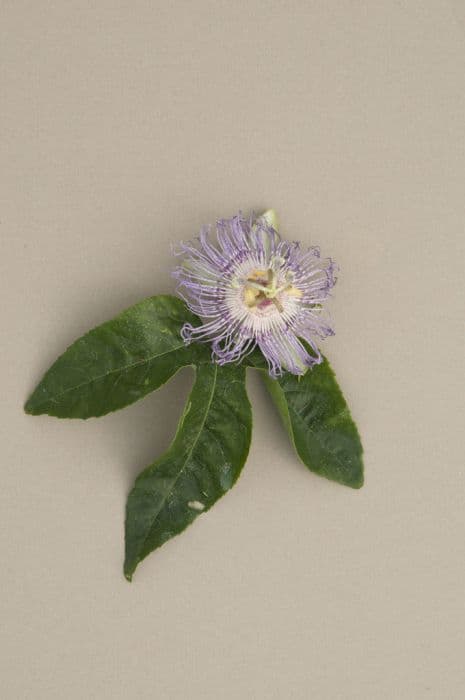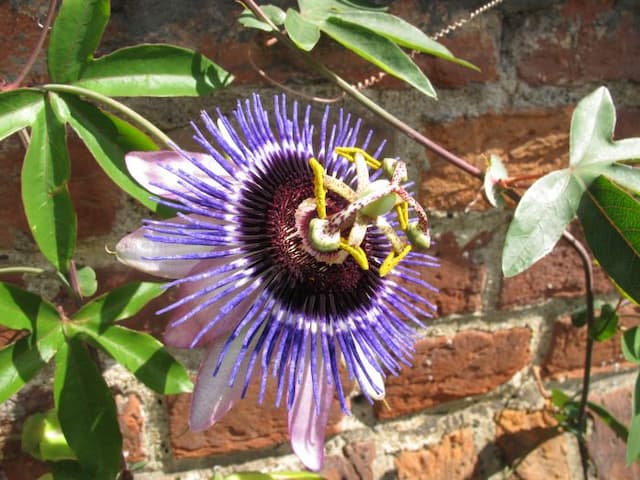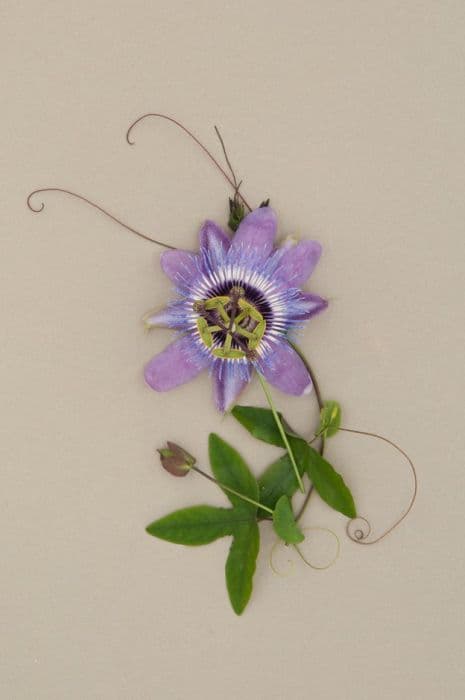Passion Flower Passiflora × violacea

ABOUT
The plant known as Passion Flower boasts remarkable and intricate flowers. These blossoms exhibit a vibrant mix of colors, with a prominent purple hue complemented by white. The petals and sepals spread out flatly, while a distinctive corona emerges in a frilly halo of thread-like structures, often banded with contrasting colors such as white, purple, or even blue. At the center, the reproductive parts including stamens and pistils create a dramatic focal point, contributing to the flower's complex architecture. The leaves of the Passion Flower are equally noteworthy—typically dark green, they have a glossy appearance and are deeply lobed with three distinct sections, sometimes with a slightly serrated edge. The foliage provides a lush backdrop for the flowers. This Fusion Flower, as a climber, has tendrils that it uses to twine around structures, aiding in its ascent and spread. These tendrils emerge near the leaf axils, and they exhibit a graceful, spiraled form that further adds to the overall aesthetic quality of the plant. Overall, the Passion Flower is a stunning and exotic-looking plant that commands attention with its unique and elaborate flowers—a natural work of art that is frequently admired for its ornamental value.
About this plant
 Names
NamesFamily
Passifloraceae
Synonyms
Violet Passionflower, Purple Passionflower
Common names
Passiflora × violacea.
 Toxicity
ToxicityTo humans
Passiflora × violacea, commonly known as Passion Flower, is not generally considered toxic to humans. There are no well-documented cases of Passion Flower causing severe poisoning in humans; however, some parts of the plant contain cyanogenic glycosides, which can release cyanide in the body when ingested in large amounts. Symptoms of cyanide poisoning include headache, confusion, agitation, and difficulty breathing. The ingestion of significant quantities of plant material, particularly the unripe fruits, may lead to these symptoms. Nevertheless, such cases are rare, and the Passion Flower is primarily grown for ornamental purposes and is not commonly consumed.
To pets
Passion Flower may have a similar toxicity profile for pets, such as cats and dogs, as it does for humans. It is not typically considered to be highly toxic to pets. However, as with humans, the Passion Flower contains cyanogenic glycosides, which can be harmful if ingested in large amounts. Symptoms in pets can mirror those in humans, including digestive upset, confusion, and difficulty breathing. While serious cases are uncommon, it is always prudent to prevent pets from consuming large amounts of the plant, particularly the unripe fruit, to avoid potential toxicity.
 Characteristics
CharacteristicsLife cycle
Perennials
Foliage type
Evergreen
Color of leaves
Green
Flower color
Violet
Height
10 feet [3 m]
Spread
6 feet [1.8 m]
Plant type
Climber
Hardiness zones
9
Native area
South America
Benefits
 General Benefits
General Benefits- Landscape Aesthetics: Known as the hybrid passion flower, Passiflora × violacea is valued for its striking purple flowers which add visual interest to gardens and landscapes.
- Pollinator Attraction: The plant's vibrant flowers attract a variety of pollinators, including bees, butterflies, and hummingbirds, supporting local ecosystems.
- Food Source for Fauna: The Passion Flower serves as a larval host plant for several species of butterflies, providing a food source for caterpillars.
- Shade and Privacy: With its climbing habit, the hybrid passion flower can be used to create shaded areas and natural screens for privacy in gardens.
- Educational Interest: The unique floral structure of the passion flower often serves as an educational tool to teach about plant biology and pollination.
 Medical Properties
Medical PropertiesThis plant is not used for medical purposes.
 Air-purifying Qualities
Air-purifying QualitiesThis plant is not specifically known for air purifying qualities.
 Other Uses
Other Uses- Passiflora × violacea, commonly known as Passion Flower, can be used for educational purposes in botany classes to demonstrate unique floral structures and pollination mechanisms.
- The complex blooms of the Passion Flower make for a fascinating subject in macro photography, highlighting the intricate details of plant reproductive parts.
- Some people use dried Passion Flower vines and flowers for crafting, such as in making natural wreaths or floral arrangements.
- Passion Flower vines can be used in landscape design to cover trellises, arbors, and fences, creating lush, tropical-inspired outdoor spaces.
- As an ornamental feature in ponds or water gardens, Passion Flower can be grown near the water to provide a natural aesthetic with its trailing vines.
- In culinary arts, Passion Flower blossoms are sometimes candied and used as edible decor for desserts and pastries.
- The plant is often a subject of botanical illustration and art due to its exotic appearance and the challenge it presents in accurately capturing its complexity.
- Passion Flower can be used as a living screen to provide privacy in balconies and small gardens, due to its vigorous climbing habit.
- Butterfly and hummingbird enthusiasts may cultivate Passion Flower in their gardens to attract and support these pollinators, contributing to biodiversity.
- During themed events or celebrations, such as Easter, the Passion Flower serves as a symbol and a decorative element due to its association with the Passion of Christ in Christian symbolism.
Interesting Facts
 Feng Shui
Feng ShuiThe Passion Flower is not used in Feng Shui practice.
 Zodiac Sign Compitability
Zodiac Sign CompitabilityThe Passion Flower is not used in astrology practice.
 Plant Symbolism
Plant Symbolism- Faith - The structure of the passiflora, or passion flower, has long been associated with elements of the Christian crucifixion story ("The Passion"), symbolizing faith and belief.
- Enduring Love - Passion flowers have a persistent and climbing nature, which can symbolize the relentless and enduring aspect of love.
- Spiritual Enlightenment - With its vibrant and complex structure, the passion flower can represent a journey towards spiritual understanding and awakening.
- Suffering and Sacrifice - The name "passion flower" itself is a reference to the Passion of Christ, thereby symbolizing Christ's suffering and sacrifice.
- Mystery and the Unknown - The intricate and elaborate appearance of the passion flower can evoke feelings of mystery and symbolize the depths of the unknown.
 Water
WaterFor the passionflower (Passiflora × violacea), the watering frequency should be consistent to keep the soil moist but not waterlogged. Water the plant deeply once a week, providing about 1 to 1.5 gallons of water for outdoor plants, and adjust based on weather conditions. Indoor plants may require less water, closer to 8-16 onzes per week, depending on pot size and indoor climate. Increase watering during the growing season in spring and summer, and reduce it in fall and winter when the plant is dormant.
 Light
LightPassionflower (Passiflora × violacea) thrives best in full sun to partial shade. Ideally, place it in a spot where it receives at least 4-6 hours of direct sunlight daily. If grown indoors, a sunny windowsill or a space with bright, indirect light is suitable for this plant.
 Temperature
TemperaturePassionflower (Passiflora × violacea) prefers a temperature range between 55°F and 85°F. It can survive temporarily at temperatures as low as 40°F and as high as 100°F. However, the ideal growth temperatures are within 60°F to 78°F.
 Pruning
PruningPassionflower (Passiflora × violacea) should be pruned to maintain shape, remove dead wood, and encourage new growth. Prune in the early spring before new growth begins or just after the last frost. Prune vigorously to stimulate bushiness but always leave several buds on each stem for future growth.
 Cleaning
CleaningAs needed
 Soil
SoilThe best soil mix for the Passionflower should be light, well-draining, and rich in organic matter. A mixture of loam, peat, and sand in equal parts is recommended to provide proper aeration and moisture retention. The soil pH should be slightly acidic to neutral, ranging from 6.0 to 7.0.
 Repotting
RepottingPassionflowers should be repotted every 2-3 years or when they outgrow their current pot. Springtime is ideal for repotting to minimize stress on the plant and promote quick recovery.
 Humidity & Misting
Humidity & MistingPassionflowers prefer high humidity levels, ideally between 50% to 70%. They thrive in moist air and may require additional humidity through misting or a humidity tray if indoor air is dry.
 Suitable locations
Suitable locationsIndoor
Ensure bright, indirect light and consistent warmth for indoor growth.
Outdoor
Plant in a sunny or semi-shaded spot, protected from strong winds.
Hardiness zone
9-11 USDA
 Life cycle
Life cyclePassiflora 'Amethyst', a hybrid passion flower, starts its life as a seed, requiring warm, moist soil to germinate, typically taking one to three weeks. Upon sprouting, the seedling grows into a vigorous vine, with distinctive lobed leaves and coiling tendrils that help it climb. A perennial, it enters a rapid vegetative stage, developing a strong root system and extensive foliage. After establishing, it begins the reproductive stage, producing intricate purple and white flowers during the warmer months which are pollinated by insects. Following pollination, it may bear oval-shaped fruit containing seeds, continuing the cycle if conditions permit. During colder months, in non-tropical climates, the plant may die back to the ground to become dormant, resuming growth with the return of favorable weather.
 Propogation
PropogationPropogation time
Spring-Early Summer
The most popular method of propagating Passiflora × violacea, commonly known as hybrid passionflower, is through semi-hardwood cuttings. This is best done in the late summer months. To propagate using this method, select a healthy, semi-hard stem that has recently flowered and cut a section of about 4 to 6 inches (10 to 15 centimeters) long. Remove the lower leaves, dip the cut end into rooting hormone powder, and insert into a pot filled with a mix of peat and perlite. Maintain a high humidity environment to encourage rooting, often achieved by placing the pot inside a propagator or covering it with a plastic bag. Roots typically develop within a few weeks after which the new plant can be gradually acclimatized to less humid conditions.









